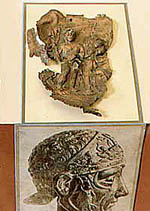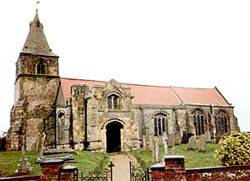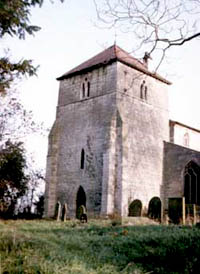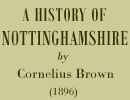< Previous | Contents | Next >
Brough, Holme, Muskham Norwell, North & South Collingham, Langford and Fledborough

Cheekpiece from a Roman ceremonial helmet found at Brough, now in Newark Museum.
AMONG the places once of historic importance, but now only consisting of a few scattered houses, is the little hamlet of Brough, lying about three miles to the north of Newark. It was, without doubt, the Roman Crocolana, and under this name the station appears in the Itinerarum Antonini. Great numbers of Roman coins have been found here, and they were so common at one time as to be denominated ‘Brough pennies.’ Dr. Stukeley, the antiquary, mentions the tradition that there was a church upon a place called Chapel Yard, and speaks of ‘great foundations being met with on either side of the road for half a mile together.’
The destruction of the place is attributed to ‘one of those ruthless forays which made the reign of Edmund Ironsides so unquiet,’ in which case it would be demolished about 1016. There are no old remains of any kind now visible. Potter Hill, close by, has been considered the site of a Roman outpost; and on Danethorpe Hills human remains and coffins have been dug up.
A little to the west lies Holme, on the banks of the Trent, and here there is a very interesting old church, with many memorials of the Barton family. The Bartons, who were large property owners in Lancashire, possessed the greater part of Holme early in the seventeenth century, and one of them, a merchant of the staple, built ‘a fair stone house here,’ in the windows of which he placed this posie:
‘I thank God, and ever shall,
It is the sheep that paid for all.’

St Giles' church, Holme dates largely from the late 15th century and was rebuilt by John Barton (A. Nicholson, 1999).
By marriage the estate was conveyed to Lord Bellasis, the gallant Governor of Newark at the time of its surrender. Dr. Wake, in his ‘History of Collingham,’ referring to the house at Holme, says: ‘Only a part of the original building remains. It is generally believed that an underground communication exists between this house and the church.’ Dick Turpin, the famous outlaw, is said to have found shelter in a cottage in this village.
The adjoining village of Muskham also gave its name in early days to an influential family, of whom one Geoffrey de Muskham (spelt Muschamp) was consecrated Bishop of Lichfield in 1198.
From Norwell, near Muskham, came William de Northwell, who became Baron of the Exchequer (temp. Edward III.), and of whom some details are given in Foss’s ‘judges.’ In this village there were at one time three prebends of the collegiate church of Southwell and six large houses or halls, moated round.
North and South Collingham are two populous parishes, the centre of a fertile agricultural district. Dr. Wake traces their origin to Saxon times, and their nearness to the Crocolana (Brough) of the Romans renders probable the surmise that the existence of the community extends back to very early times. In 1042 Peter de Burgh, Abbot of Peterborough, was taxed for a manor at ‘Colingeham.’ Subsequent owners of land here were Ralph, son of Robert de Colingham, and Walter, son of Alured de Colingham, Sir Hugh de Babington, Sir Henry de Perepont, and Nicholas de Breydestone. There are fine churches in the Early English style in both North and South CoIling-ham, and each of the sacred edifices has been restored carefully and judiciously. Dr. Blow, the composer of Charles II.’s time, was born at Collingham. In the immediate vicinity are the parishes of Besthorpe (whose name implies Danish origin); North and South Scarle, or Scorveley, as they appear in Domesday Book; Stapleford, with its moor; and Langford (or Landford), the land near the ford, a parish close to the river.

St Gregory, Fledborough. The lower stages of the tower are Norman; the upper part is 13th century.(A. Nicholson, 1983).
Another interesting Trent-side village is Fledborough. Godiva, the famous Countess of the Saxon Earl Leofric of Mercia, is the earliest owner of the manor of whom we have any record, and this lady, on pious deeds intent, gave it, with Newark, to the church at Stowe. After the Conquest it was occupied by one Nigellus, as tenant of the Bishop of Lincoln. Then there came upon the scene members of the Norman family, De Lisieux, who held the manor of the Bishop as chief lord, and it was during their residence here that the great work of building a new church was commenced. The estate passed from Lisieux to a still more famous family—that of Basset, some of whom had occupied positions of great influence and power. The Bassets, like the men they succeeded at Fledborough, were of Norman birth, and had been enriched by royal grants until they were the owners of considerable property in the Midlands. They attained great eminence as judges and military men, and intermarried with many distinguished families. Fledborough passed from the Bassets by purchase to the feoffees of the Earl of Shrewsbury, and subsequently the manor became part of the possessions of the Earl of Kingston.
The sacred edifice is still of fair proportions, but it is much smaller than in the days of the Knights of Norman descent who assisted in its erection. In 1764 the church had become sadly in need of repair, and in response to a petition from the inhabitants the Duke of Kingston and the Archbishop of York co-operated with the Rector to build up out of the crumbling walls a neat and snug building. The portion of the north aisle between the pillars of the first bay has evidently been a chantry chapel, and is believed to have been connected with Woodcotes, a hamlet to Fledborough. The seats in the north aisle chapel have always been appropriated to Woodcotes farmers. The secluded situation of Fledborough, and the residence there of an accommodating Rector, who rejoiced in the name of Sweetapple, caused it to be regarded in the earlier part of the last century as the Gretna Green of the Midlands. Hither runaway couples journeyed to be united in the bonds of wedlock, and Rector Sweetapple, who was surrogate, and profited by the licence fees, drove a brisk trade. The register shows two, three, and four marriages at the beginning of his reign, and it ends with forty-two and forty-four per annum at the time of his death. It is said that a nobleman was married here under an assumed name, but there is no hint of it in the register.
More interesting than the Sweetapple episode is the connection of Dr. Arnold with the parish, he having married on August 11, 1820; Mary, youngest daughter of the Rev. John Penrose, Rector of Fledborough, and sister of one of his earliest school and college friends. The licence is still extant, and is carefully kept with the entry in the register. Fledborough is several times mentioned in the life of Dr. Arnold by Dean Stanley, and Keble also mentions it. Mr. Penrose was a man of much culture and amiability, with a wide circle of friends. One of his daughters was Mrs. Markham, the writer of the well-known History of England for children.
